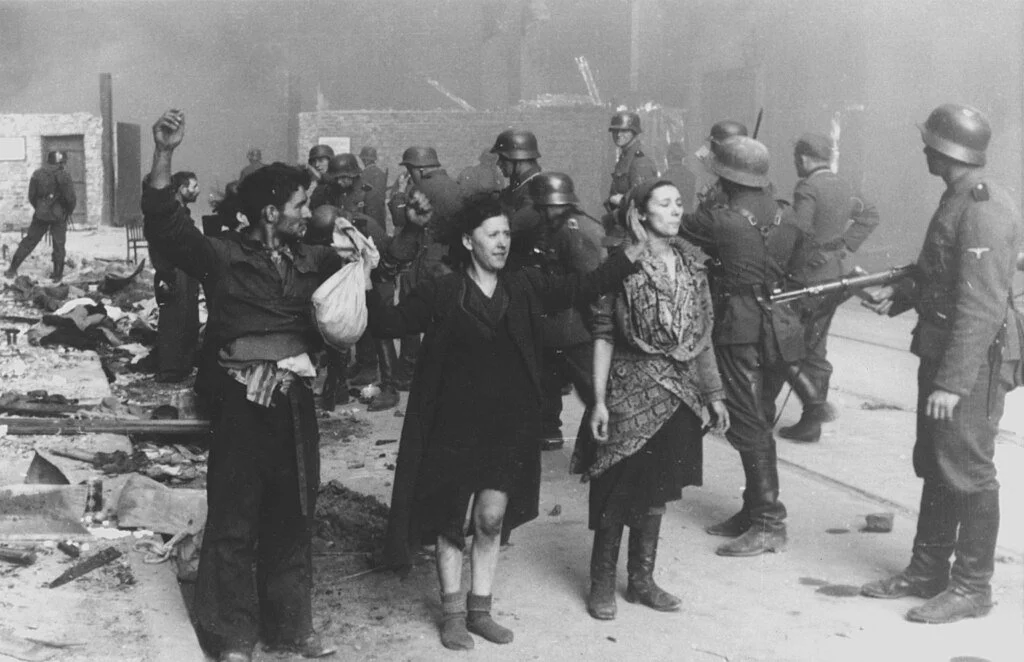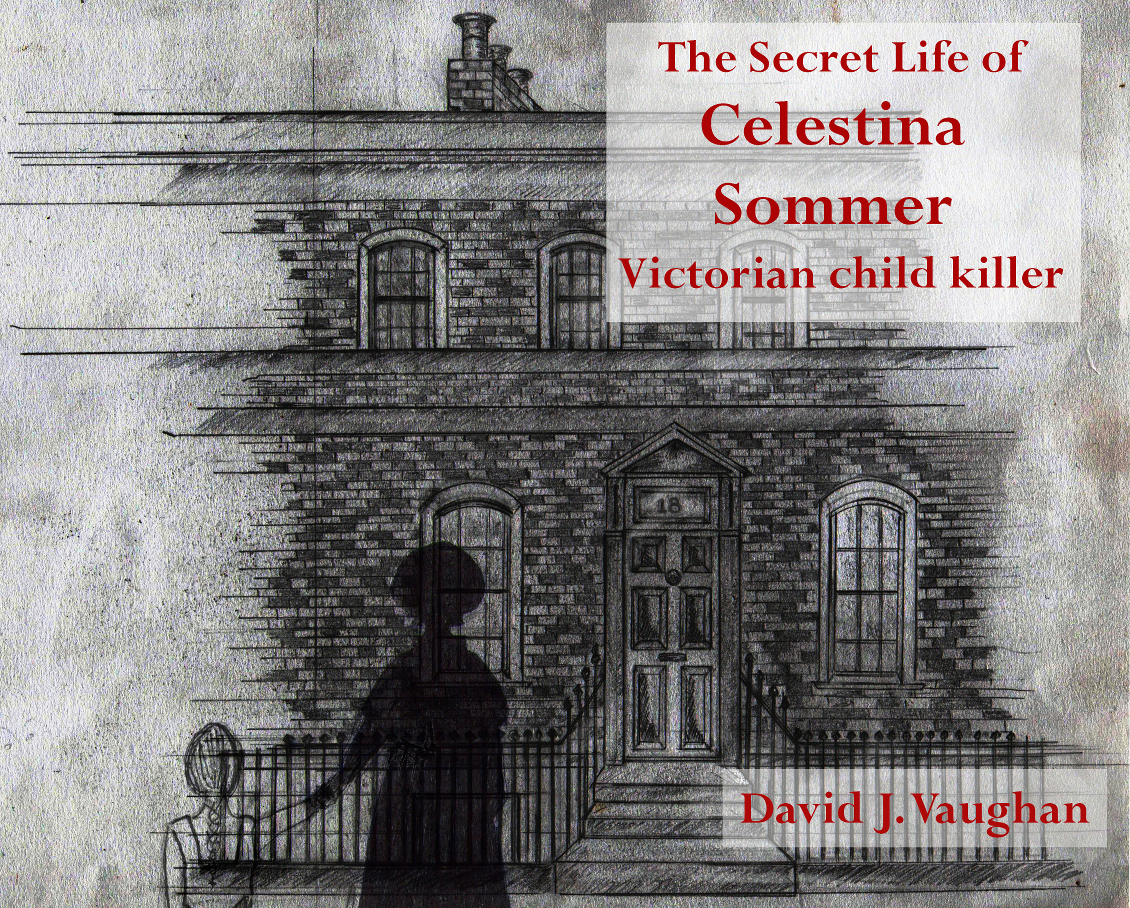When the Nazis invaded Poland in 1939, they had to determine how the increasing numbers of Jews would be controlled. Their temporary solution was to section the Jews off into ghettos, and Jewish methods of resistance must be seen in the context of that environment.
Heather Voight explains.
Resistance members captured during the Warsaw Ghetto Uprising.
A cursory reading of a Holocaust textbook would lead most readers to conclude that Polish Jews failed to respond to persecution prior to the Warsaw ghetto uprising in 1943. In order to determine whether the Jews resisted their oppressors, however, the term resistance must be defined. Webster’s New World Dictionary defines the word resist as “to oppose actively; fight, argue, or work against; to refuse to cooperate with, submit to, etc.” According to this definition, the Jews could resist their oppressors in other ways besides warfare, though physical fighting was sometimes involved. Patterns of resistance did not remain static but changed just as the situation of Jews changed. Polish Jews in the ghettos altered their response to persecution as the types of persecution they faced changed, but some form of resistance was ever-present.
Smuggling Food as Resistance
The Jews in Polish ghettos had every intention of surviving the war. In order to accomplish this, they needed more food than the meager Nazi provisions. Food supplies to inhabitants of the Warsaw ghetto each had a caloric value of 220, 15% of the normal daily requirement. Jews acquired the food they needed through smuggling. Adam Czerniakow, leader of the Warsaw Judenrat, a council of Jews created by the Nazis to carry out their orders, estimated that smuggling accounted for 80% of the food available in the Warsaw ghetto. Many smugglers were women and children who managed to circumvent the Nazi guards. Renia Kukielka went out of the Jedrzejow ghetto with her sisters to trade lace placements for coins that were used to buy food. Other young women served as couriers, smuggling out food and medicine.
Regardless of who did the smuggling, it was a dangerous task. Abraham Lewin, who kept a diary while in the Warsaw ghetto, wrote about children going over to the Aryan side to get potatoes. “There are some Germans who show a little mercy for these unfortunate children and pretend not to see, turning away deliberately, and the children dart with their little overcoats bulging…There are also vicious guards who hit the children with murderous blows…more than one child has fallen victim to their bloodlust.” Yet the Jews continued to engage in smuggling despite the bloodshed. The Nazis hoped the Jews would starve and thus disappear, but children and adults bravely resisted by smuggling food.
Music as Resistance
The people in the ghettos also continued to participate in cultural activities such as concerts. Though the Nazis didn’t allow Aryan music, Jewish musicians in the Warsaw ghetto still played to large audiences, which sometimes included Poles on the Aryan side of the ghetto. Not everyone thought these performances were appropriate, however. In his diary, Adam Czerniakow wrote, “Many people hold a grudge against me for organizing play activity for the children, for arranging festive openings of playgrounds, for the music, etc. I am reminded of a film: a ship is sinking and the captain, to raise the spirits of the passengers, orders the orchestra to play a jazz piece. I had made up my mind to emulate the captain.” Czerniakow understood that culture should continue regardless of what the Nazis did. Other ghettos also held concerts, including one of Poland’s most isolated ghettos in Lodz. Musical concerts in the ghetto resumed two months after deportations. Despite the loss of family and community members, Jewish creativity went on.
Religious Observance as Resistance
In defiance of the Nazi order which forbade all public religious practices, religious life for Jews in the ghettos simply went underground. Warsaw ghetto diarist Chaim Kaplan wrote, “Public prayer in these dangerous times is a forbidden act..But this does not deter us. Jews come to pray in a group in some inside room facing the courtyard, with drawn blinds on the windows.” Given their followers’ unprecedented circumstances, some tenets of Jewish law were modified. For example, people could not keep the sabbath because the Nazis forced them to work. Rabbis also permitted the consumption of non-kosher food because the preservation of life was more important than dietary laws. Though they had to practice their religion differently, the Jews did not surrender their beliefs.
Education as Resistance
In addition to religious practices, the Nazis banned education in the Warsaw ghetto and others. Nevertheless, students and teachers found ways to meet. As early as 1939, teachers received bread in exchange for teaching groups of 4-8 children for a few hours. Unfortunately, there is no information on the number of these groups in the Polish ghettos because of the secrecy involved. As Chaim Kaplan explained in his diary: “It is possible that the ban against study also applies to such small groups, and if questions were asked they would have to be stopped. But no one asks questions. The matter is done quietly, underhandedly. There is no other solution.”
Education wasn’t limited to younger students. High school and college age students helped to organize education for themselves in consort with their teachers. A Zionist youth movement organized an illegal high school in the Warsaw ghetto which existed between 1940 and summer 1942. It wasn’t a high school in the traditional sense since teachers travelled to the students’ apartments. Yet by spring of 1942 the school had 120 pupils and 13 teachers. Courses included math, history, biology, philosophy and literature. There were also university level courses in education and medicine. In spite of the Nazi ban on education, teachers and students were determined to provide knowledge that students would need if they survived the conditions of the ghettoes and the eventual deportations.
Writing as Resistance
Jews in the ghettos also used writing to keep the world and each other informed about the Nazi’s plans to exterminate the Jews. Jews sometimes escaped from concentration camps to the tenuous safety of the Warsaw ghetto. They told the inhabitants of the Nazi’s plans to kill them all. Courier girls who initially smuggled food and medicine began to smuggle underground writings.
In addition to communicating within the Polish ghettos, coded postcards from courier girls were sent to Jews outside Poland. Frumka Plotnicka wrote, “I am waiting for visits from guests: Machanot and Avodah should be coming here.” Machanot and Avodah were Hebrew words for camp and work. “Pruetnitsky and Schitah lived with me.” These are Hebrew words for pogroms and destruction. By using words the Nazis couldn’t decode, Jews in Polish ghettos warned others about their fate.
One of the most lasting ways that Jews defied the Nazis was by documenting their experiences. Secret archives were established to preserve the history of life in the ghettos. The Oneg Shabbat of Warsaw was established by Dr. Emanuel Ringelblum. He persuaded people like former teacher Abraham Lewin to contribute their accounts. Part of Lewin’s diary was discovered in a milk pail after the war. The partial diary covers late March 1942 to January 1943. Lewin wrote in June 1942, “We gather every Sabbath, a group of activists in the Jewish community, to discuss our diaries and writings. We want our sufferings, these ‘birth pangs of the Messiah’ to be impressed upon the memories of future generations and on the memory of the whole world.” Lewin’s diary entries got shorter whenever deportations to the death camps were increased. For example, he struggled to describe his heartbreak when his wife was deported in August 1942. “I have no words to describe my desolation. I ought to go after her, to die. But I have no strength to take such a step.” Although Lewin often found it difficult to write about the actions of the Nazis, his diary and others like it testify to the horrors of the Holocaust.
Violence as Resistance
Although much of Jewish resistance prior to the Warsaw ghetto uprising was nonviolent, this was not always the case. For example, in fall of 1942 Jews in the town of Lubliniec were ordered to gather in the market and undress. Naked Jewish women began attacking the officers, biting them and throwing stones. The Nazis ran away. The headline in the Jewish Telegraphic Agency’s report read “Jewish Resistance in Poland: Women Trample Nazi Soldiers.” A bit later in the year, an armed act of violence by Jews in Krakow occurred. On December 22, 1942, 40 Jewish men and women fighters descended upon three coffee houses and bombed a Nazi Christmas party. Others threw grenades into another café. Their efforts killed at least seven Nazis and wounded many more. The Jewish resistance leaders were killed but others still bombed targets outside the city. Most importantly, Jews who used violence to resist inspired those who became part of the larger Warsaw ghetto uprising.
Did you find that piece interesting? If so, join us for free by clicking here.
References
Batalion, Judy. The Light of Days: The Untold Story of Women Resistance Fighters in Hitler’s Ghettos. New York: HarperCollins, 2020.
Bauer, Yehuda. A History of the Holocaust. Danbury, CT: Franklin Watts, 1982.
Dwork, Deborah and Robert Jan van Pelt. Holocaust: A History. New York: W.W. Norton and Co., 2002.
Lewin, Abraham. A Cup of Tears: A Diary of the Warsaw Ghetto. Edited by Antony Polonsky. New York: Basil Blackwell Inc., 1989.







